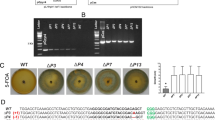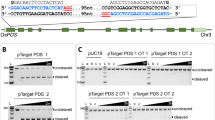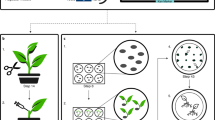Abstract
Barley powdery mildew, Erysiphe graminis f.sp. hordei, is an obligate biotrophic pathogen and as such cannot complete its life cycle without a living host. The inability to transform this fungus and manipulate its genome has constrained research towards understanding its life cycle and pathogenicity. Here we describe an in planta transformation system based on delivery of DNA using a gold-particle gun and selection using benomyl or bialaphos. Using this method, we consistently obtained stable transformants with efficiencies comparable to other filamentous fungi. Stable expression of the β-glucuronidase in E. graminis was demonstrated by co-transforming the uidA gene with the selectable markers.
This is a preview of subscription content, access via your institution
Access options
Subscribe to this journal
Receive 12 print issues and online access
$209.00 per year
only $17.42 per issue
Buy this article
- Purchase on Springer Link
- Instant access to full article PDF
Prices may be subject to local taxes which are calculated during checkout



Similar content being viewed by others
References
Hewitt, H. Fungicides in crop protection. (CAB International, Wallingford, UK, 1999).
Hall, A.A., Carver, T.L.W., Zhang, Z. & Gurr, S.J. in Encyclopedia of microbiology. (ed. Alexander, B.A.H.) 269– 276 (Academic Press, San Diego, CA; 2000).
Oliver, R.P. et al. Aquisition and analysis of an EST database of barley powdery mildew: signal transduction pathways. Fungal Genet. Newslett. 46S, 86 (1999).
Gold, S.E., Bakkeren, G. & Kronstad, J.W. Three selectable markers for transformation of Ustilago maydis. Gene 142, 225– 230 (1994).
Koenraadt, H. & Jones, A.L. Resistance to benomyl conferred by mutations in codon 198 or 200 of the beta-tubulin gene of Neurospora crassa and sensitivity to diethofencarb conferred by codon 198. Phytopathology 83, 850–854 (1993).
Yarden, O. & Katan, T. Mutations leading to substitutions at amino acids 198 and 200 of beta-tubulin that correlate with benomyl-resistance phenotypes of Botrytis cinerea. Phytopathology 83, 1478–1483 (1993).
Sherwood, J.E. & Somerville, S.C. Sequence of the Erysiphe graminis f.sp. hordei gene encoding β-tubulin. Nucleic Acids Res. 18, 1052 ( 1990).
Thomson, C.J. et al. Characterization of the herbicide-resistance bar from Streptomyces hygroscopicus. EMBO J. 6, 2519–2523 (1987).
Straubiger, B., Straubiger, E., Wirsel, S., Tureon, G. & Yoder, O. Versatile fungal transformation vectors carrying the selectable bar gene of Streptomyces hygroscopicus. Fungal Genet. Newslett. 39, 82–83 (1992).
Pall, M.L. The use of Ignite (BASTA; glufosinate; phosphothricin) to select transformants of bar-containing plasmids in Neurospora crassa. Fungal Genet. Newslett. 40, 58–62 ( 1993).
Wilmink, A. & Dons, J.J.M. Selective agents and marker genes for use in transformation of monocotyledonous plants. Plant Mol. Biol. Reporter 11, 165–185 (1993).
Kistler, H.C. & Benny, U. Autonomously replicating plasmids and chromosome rearrangement during transformation of Nectria haematococca . Gene 117, 81–89 (1992).
Javerzat, J.-P., Bhattacherjee, V. & Barreau, C. Isolation of telomeric DNA from the filamentous fungus Podospora anserina and construction of a self-replicating linear plasmid showing high transformation efficiency. Nucleic Acids Res. 21, 497–504 (1993).
Long, D.M., Smidanski, E.D., Archer, A.J. & Strobel, G.A. In vivo addition of telomeric repeats to foreign DNA generates extrachromosomal DNAs in the taxol-producing fungus Pestalotiopsis microspora. Fungal Genet. Biol. 24, 335–344 (1998).
Christiansen, S.K., Knudsen, S. & Giese, H. Biolistic transformation of the obligate plant pathogenic fungus Erysiphe graminis f.sp. hordei. Curr. Genet. 29, 100–102 (1995).
Newton, A. Genetic adaptation of Erysiphe graminis f.sp. hordei to barley with partial resistance. J. Phytopathol. 126, 133–148 (1989).
Acknowledgements
We wish to thank W. Harwood for the generous gift of BASTA-resistant barley and S. Foster for discussions. This work was funded by a BBSRC grant. P.D.S. is a Royal Society University Research Fellow.
Author information
Authors and Affiliations
Corresponding author
Rights and permissions
About this article
Cite this article
Chaure, P., Gurr, S. & Spanu, P. Stable transformation of Erysiphe graminis an obligate biotrophic pathogen of barley. Nat Biotechnol 18, 205–207 (2000). https://doi.org/10.1038/72666
Received:
Accepted:
Issue Date:
DOI: https://doi.org/10.1038/72666
This article is cited by
-
Evaluation the effects of powdery mildew caused by Blumeria graminis f. sp. hordei and cultivar on the barley lodging
European Journal of Plant Pathology (2023)
-
The Bacterial and Fungal Microbiota of the Mexican Rubiaceae Family Medicinal Plant Bouvardia ternifolia
Microbial Ecology (2022)
-
Pathogenesis-related genes responses in barley plants challenged with pathogenic fungi with different lifestyles
Cereal Research Communications (2020)
-
Characterizing the pathotype structure of barley powdery mildew and effectiveness of resistance genes to this pathogen in Kazakhstan
BMC Plant Biology (2017)
-
Transient transformation of Podosphaera xanthii by electroporation of conidia
BMC Microbiology (2015)



